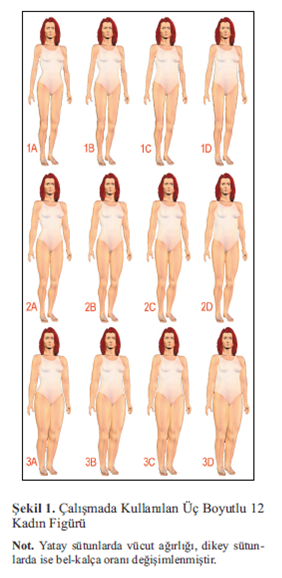My thesis project at NYU was centered around a body image (meaning a person's perception of the aesthetics and sexual attractiveness of his or her own body) study in which I showed freshman students a lineup of identical bodies, manipulating only the waist-to-hip ratio of each figure. The lineup looked similar to the figure below:

I asked each student to show me where she thought her body fell on the lineup, then after taking her measurements, showed her where she actually fell on the lineup. Members of the experimental group were told the curviest figure (about a .35--which doesn't exist in nature) was the average woman's body while the control group was shown where the average woman actually falls on the lineup (somewhere between .70-.80). I proposed that the women who thought their body was average or 'above average' would rate higher on scales of body-esteem and body-image, while the women who thought their body was farther from the average would rater lower. This data supported this trend and in addition, many of the women had a hard time differentiating between body shape and perceived fatness. All of the figures I showed them were the same weight, just a different shape.
My advisor mentioned to me that she would love to create an alternate study in which female students would try on a pair of jeans that they would be told was their size, but the jeans would really be a size larger or a size smaller to see how that affected their body-esteem. Any woman who went into the store thinking she was a size 8 but ended up needing a 10 or 12 could attest to how this feels--pretty lousy, as since childhood, the media send women the pernicious message that thinness equals value and good. But she shouldn't feel poorly--for more reasons just than one's worth is not determined even remotely by dress size.
Women's sizing in particular has been unstandardized in America since the 1920's although not due to lack of trying. In the 1940's the federal goverment commisioned a study of the American female body in an attempt to create some semblance of standard sizing, as wealthy women (who previously wore made-to-order digs) were now interested in purchasing ready-to-wear clothing, and God forbid you piss off a wealthy woman who is ready to shop.
Thanks to the military, by the War of 1812 men already had a loose sizing system based on chest measurement (with the idea that the remaining proportions could be figured out based on that one stat). Producers of womenswear soon followed suit, using the bust as its one measurement for size. NOW WHAT COULD POSSIBLY GO WRONG HERE.
Even after funding multiple projects that involved taking women's measurements, formulating sizes on height, weight and other various indexes, the government had still failed to come up with a distinct standard. (These projects were bound to fail regardless as the measurements of women of color were discarded and measurements of fitter-than-most women who served during World War II were added, thus skewing results.) Yet here and there, these faulty statistics STILL keep working their way into contemporary sizing, according to ASTM International, which is an organization that develops voluntary product standards. The new trend though is toward vanity sizing, or the phenomenon of ready-to-wear clothing of the same nominal size becoming larger over time, basically in order to accomodate the growing American waistline. And breast implants.
But other than the annoyance of trying on multiple sizes, does it really matter? The government can't get it right, how can we expect Old Navy to? Wear what fits, don't wear what doesn't. Detach your feelings to the arbitrary number on the tag and be a Size Sassy!
This is FASCINATING. Amazing research... Why don't we hear about this more?? By the way, I feel like I've read several news articles about the problematic "standard" clothing sizes, esp. for women, but I NEVER knew how the problem came about... 'til now! you rock.
ReplyDelete